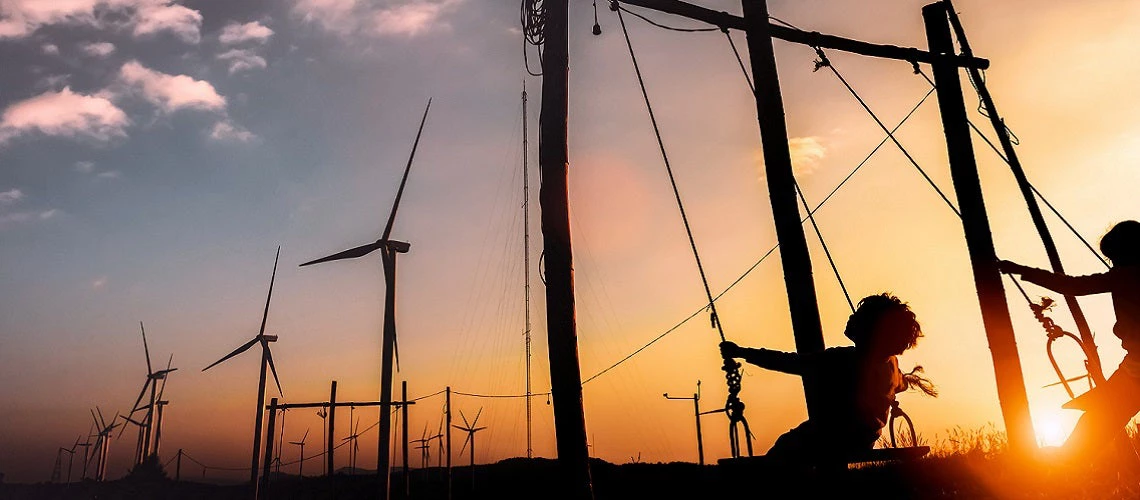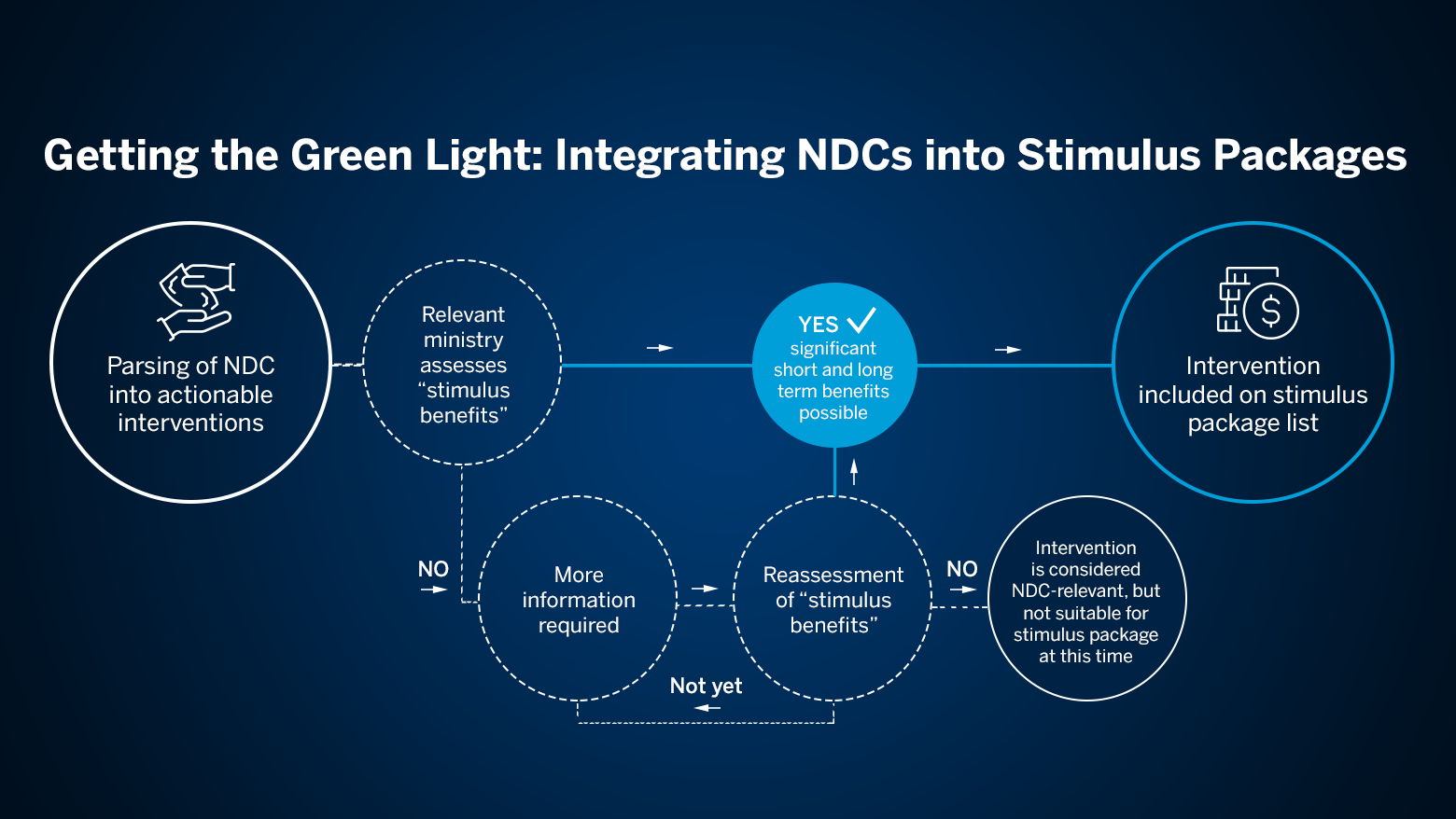 Niños balanceándose en un columpio en un parque eólico.
Niños balanceándose en un columpio en un parque eólico.
2020 was lining up to be a big year for climate action. It marked the five-year point at which countries were to step up their climate ambitions, with expectations running high that COP26 (which was scheduled for November in Glasgow) could have outcomes as consequential as COP21’s Paris Agreement in 2015. The global climate meeting has now been postponed to 2021 as countries respond to the immediate health and financial crisis posed by the coronavirus pandemic. As health concerns lessen, however, countries will need to focus on stimulus packages to stem the economic impact of COVID-19. As they do, it will be vitally important to help them build the foundation for a more resilient, sustainable, and prosperous future.
"As health concerns lessen, however, countries will need to focus on stimulus packages to stem the economic impact of COVID-19. As they do, it will be vitally important to help them build the foundation for a more resilient, sustainable, and prosperous future."
Why NDCs, Why Now
Under the terms of the Paris Agreement, new or updated National Determined Contributions (NDCs) were due from each party to the agreement in five-year cycles. These were to be submitted well in advance of Glasgow, but the COVID crisis has thrown a wrench into the process for many countries. Not only are many government staff who were involved in NDC preparation now focusing on the COVID crisis, but many of the underlying assumptions on which NDCs are based – such as the availability of domestic budget resources, borrowing headroom or access to international climate finance, economic growth and emission trajectories – are coming into question. Given the novel nature of the virus, it is also unclear how quickly things will return to “normal,” or indeed, what a new normal may look like and how it may ultimately affect a country’s level of climate ambition.
Despite these concerns, we believe that NDCs, national development strategies, and master plans or national adaptation plans deserve considerable attention in stimulus discussions. They often provide a window into the government’s vision for areas of future economic growth and technology transformation, both of which have clear linkages with job creation. They frequently have to account for complex challenges where progress can deliver multiple wins in terms of reduced poverty, enhanced competitiveness, improved public health and local quality of life, and global public goods.
Additional work will certainly be required to turn a country’s NDC into a pipeline of shovel-ready activities, given that most lack detail on the exact locale and the co-benefits achieved (or risks associated) with each proposed intervention. And we know that current NDCs alone are not enough to achieve full decarbonization of the world economy and avert the worst of the climate crisis. But they do represent the most public statement most countries have made to date on climate, and thus offer an extraordinarily helpful foundation for efforts to promote a sustainable economic recovery from COVID.
Getting the Green Light
Ministries in the lead on NDC preparation are likely best positioned to oversee the process of turning NDCs into a list of actionable stimulus ideas or investments , working in close collaboration with the Ministry of Finance or whichever other ministries hold the pen on the final stimulus package. Implementation should then be distributed across the ministries that are responsible for different sectoral interventions (for instance, Transport, Energy, Water, Agriculture, Environment) for help in fleshing out and rating interventions according to their “stimulus benefits”, effectively helping determine how quickly they can be implemented and how beneficial they will be against key criteria.
Our proposed sustainability checklist provides more granular information on these key criteria that governments may need to weigh as part of the overall recovery package. Such factors necessarily include things like the geographical distribution of stimulus interventions, whether they address inclusivity concerns, or whether they improve local labor force skills and productivity. The checklist also emphasizes the need to understand what type of corollary institutional or policy changes would be required to ensure successful delivery of each proposed intervention, so that these can be accounted for ahead of time.
A decision will be required once there is sufficient information to put an initiative on the stimulus list. This will vary given local circumstances, but one option is to put in place a regular process to update the list every few weeks (see figure below Getting the Green Light: Integrating NDCs into Stimulus Packages). This way, regardless of when the stimulus package is ready for consideration (or if a government is speaking to the World Bank or other financial institutions on a recovery package), stimulus interventions reflective of NDC goals will always be at hand.

A key challenge will be to factor in the cost of preparatory work that will be necessary for bigger, more complex interventions. Getting these shovel-ready may require engineers, legal or contracting experts, and others, whose cost may exceed available budget resources. To overcome this, grant-based resources from project preparation facilities or from different national or international climate funds may be helpful.
What’s Next
Building the bridge between NDCs and a sustainable recovery will require significant coordination, both between the ministries of each government and externally, including with international institutions. Different stakeholders can advance this effort in different ways, for instance:
- For governments: Set up a coordination mechanism jointly between ministries that oversee NDCs and the sustainable recovery, to manage the process of project consideration and keep an updated list of projects.
- For the climate finance community: Explore and establish ways to make grant support available to help with project preparation, with a focus on converting NDC commitments into actionable projects that would be competitive in stimulus discussions. Many are already thinking along these lines – including the CIFs, GCF and others – but rapidly scaling up these efforts will be vital.
- For the formal climate process: Encourage upcoming NDC submissions to include a country’s updated list as a measure to enhance cooperation and boost access to resources. The World Bank’s NDC Support Facility is already examining how its country “deep dives,” a whole-of-government approach currently being deployed in five countries and regionally in the Caribbean, can be adjusted so that it also encompasses sustainable recovery needs.
- For financial and lending institutions: Take the updated list as a client government’s priorities and support them through financial and technical assistance.
Governments around the world have spent considerable time and effort in recent months and years preparing new NDCs that chart a safer and more sustainable future for their citizens. Taking these on board now as part of recovery planning can help us all build back better from the current crisis.




Join the Conversation